Optimizing Router Placement of Indoor Wireless Sensor Networks in Smart Buildings for IoT Applications
Abstract
1. Introduction
- The development and deployment of a new technique that would result in a synthesis of backbone network architecture having a smaller number of routers in smaller amount of time, ensuring high fidelity connectivity between the EDs and the BS, throughout the target space.
- Develop an interactive CAD based on a smart approach for optimal router placement.
- Combine the benefits of the developed CAD and the experience of design engineers in an automatized manner.
2. Proposed Approach
2.1. Walkthrough
2.2. Illustration with a Simple Network Setup
3. Application and Results
3.1. Case Study 1
3.2. Case Study 2
3.3. Case Study 3
4. Conclusions
Author Contributions
Funding
Acknowledgments
Conflicts of Interest
Abbreviations
| BS | Base Station |
| BAS | Building Automation System |
| CAD | Computer-Aided Design |
| EDs | End Devices |
| GUI | Graphical User Interface |
| IoT | Internet of Things |
| MILP | Mixed Integer Linear Programming |
| WSN | Wireless Sensor Network |
References
- Obeid, A.M.; Karray, F.; Jmal, M.W.; Abid, M.; Qasim, S.M.; BenSaleh, M.S. Towards realization of wireless sensor network-based water pipeline monitoring systems: A comprehensive review of techniques and platforms. IET Sci. Meas. Technol. 2016, 10, 420–426. [Google Scholar] [CrossRef]
- Serra, R.; Nabi, M. Wireless coexistence and interference test method for low-power wireless sensor networks. IET Sci. Meas. Technol. 2015, 9, 563–569. [Google Scholar] [CrossRef]
- De Araújo, P.; Filho, R.; Rodrigues, J.; Oliveira, J.; Braga, S. Infrastructure for Integration of Legacy Electrical Equipment into a Smart-Grid Using Wireless Sensor Networks. Sensors 2018, 18, 1312. [Google Scholar] [CrossRef] [PubMed]
- Tümer, A.E.; Gündüz, M. Energy-Efficient and Fast Data Gathering Protocols for Indoor Wireless Sensor Networks. Sensors 2010, 10, 8054–8069. [Google Scholar] [CrossRef] [PubMed]
- Cerchecci, M.; Luti, F.; Mecocci, A.; Parrino, S.; Peruzzi, G.; Pozzebon, A. A Low Power IoT Sensor Node Architecture for Waste Management Within Smart Cities Context. Sensors 2018, 18, 1282. [Google Scholar] [CrossRef] [PubMed]
- Jutila, M. An Adaptive Edge Router Enabling Internet of Things. IEEE Internet Things J. 2016, 3, 1061–1069. [Google Scholar] [CrossRef]
- Yu, W.; Li, X.; Yang, H.; Huang, B. A multi-objective metaheuristics study on solving constrained relay node deployment problem in WSNS. Intell. Autom. Soft Comput. 2018, 24, 367–376. [Google Scholar] [CrossRef]
- Ssajjabbi Muwonge, B.; Pei, T.; Sansa Otim, J.; Mayambala, F. A Joint Power, Delay and Rate Optimization Model for Secondary Users in Cognitive Radio Sensor Networks. Sensors 2020, 20, 4907. [Google Scholar] [CrossRef] [PubMed]
- Wang, J.; Gao, Y.; Zhou, C.; Simon Sherratt, R.; Wang, L. Optimal coverage multi-path scheduling scheme with multiple mobile sinks for WSNs. Comput. Mater. Contin. 2020, 62, 695–711. [Google Scholar] [CrossRef]
- Wang, J.; Ju, C.; Gao, Y.; Sangaiah, A.K.; Kim, G.J. A PSO based energy efficient coverage control algorithm for wireless sensor networks. Comput. Mater. Contin. 2018, 56, 433–446. [Google Scholar]
- Yang, J. Indoor Localization System Using Dual-Frequency Bands and Interpolation Algorithm. IEEE Internet Things J. 2020, 1. [Google Scholar] [CrossRef]
- Lin, H.; Bai, D.; Gao, D.; Liu, Y. Maximum Data Collection Rate Routing Protocol Based on Topology Control for Rechargeable Wireless Sensor Networks. Sensors 2016, 16, 1201. [Google Scholar] [CrossRef] [PubMed]
- Buzura, S.; Iancu, B.; Dadarlat, V.; Peculea, A.; Cebuc, E. Optimizations for Energy Efficiency in Software-Defined Wireless Sensor Networks. Sensors 2020, 20, 4779. [Google Scholar] [CrossRef] [PubMed]
- Mozumdar, M.M.R.; Gregoretti, F.; Lavagno, L.; Vanzago, L.; Olivieri, S. A framework for modeling, simulation and automatic code generation of sensor network applications. In Proceedings of the 5th Annual Communications Society Conference on Sensor, Mesh and Ad Hoc Communications and Networks, SECON’, San Francisco, CA, USA, 16–20 June 2008; pp. 515–522. [Google Scholar]
- Rahman Mozumdar, M.M.; Lavagno, L.; Vanzago, L.; Sangiovanni-Vincentelli, A.L. HILAC: A framework for Hardware in the Loop simulation and multi-platform automatic code generation of WSN applications. In Proceedings of the International Symposium on Industrial Embedded Systems (SIES), Trento, Italy, 7–9 July 2010; pp. 88–97. [Google Scholar]
- Mozumdar, M.M.R.; Ganesan, A.; Ameri, A. Synthesizing sensor networks backbone architecture for smart buildings. IEEE Sens. J. 2014, 14, 4273–4283. [Google Scholar] [CrossRef]
- Yang, H.; Kim, B.; Lee, J.; Ahn, Y.; Lee, C. Advanced Wireless Sensor Networks for Sustainable Buildings Using Building Ducts. Sustainability 2018, 10, 2628. [Google Scholar] [CrossRef]
- Mokhlespour Esfahani, M.; Nussbaum, M. Preferred Placement and Usability of a Smart Textile System vs. Inertial Measurement Units for Activity Monitoring. Sensors 2018, 18, 2501. [Google Scholar] [CrossRef] [PubMed]
- Puggelli, A.; Mozumdar, M.M.R.; Lavagno, L.; Sangiovanni-Vincentelli, A.L. Routing-aware design of indoor wireless sensor networks using an interactive tool. IEEE Syst. J. 2015, 9, 717–727. [Google Scholar] [CrossRef][Green Version]
- Mozumdar, M.; Ganesan, A.; Daragheh, A.A. Optimizing router nodes placement for designing distributed sensor networks. In Proceedings of the 2014 International Conference on Distributed Computing in Sensor Systems (DCOSS 2014), Marina Del Rey, CA, USA, 26–28 May 2014; pp. 344–348. [Google Scholar]
- Pinto, A.; D’Angelo, M.; Fischione, C.; Scholte, E.; Sangiovanni-Vincentelli, A. Synthesis of embedded networks for building automation and control. In Proceedings of the American Control Conference, Seattle, WA, USA, 11–13 June 2008; pp. 920–925. [Google Scholar]
- McGibney, A.; Klepal, M.; O’Donnell, J.T. Design of underlying network infrastructure of smart buildings. In Proceedings of the 4th International Conference on Intelligent Environments, Seattle, WA, USA, 21–22 July 2008; pp. 1–4. [Google Scholar]
- Wang, Y.C.; Hu, C.C.; Tseng, Y.C. Efficient deployment algorithms for ensuring coverage and connectivity of wireless sensor networks. In Proceedings of the 1st International Conference on Wireless Internet (WICON 2005), Budapest, Hungary, 10–15 July 2005; pp. 114–121. [Google Scholar]
- Chang, J.J.; Hsiu, P.C.; Kuo, T.W. Search-oriented deployment strategies for wireless sensor networks. In Proceedings of the 10th International Symposium on Object and Component-Oriented Real-Time Distributed Computing (ISORC 2007), Thera, Greece, 7–9 May 2007; pp. 164–171. [Google Scholar]
- Sayad, L. Optimal placement of mesh routers in a wireless mesh network with mobile mesh clients using simulated annealing. In Proceedings of the 5th International Symposium on Computational and Business Intelligence(ISCBI 2017), Dubai, UAE, 11–14 August 2017; pp. 45–49. [Google Scholar]
- Sayad, L.; Aissani, D.; Bouallouche-Medjkoune, L. Placement optimization of wireless mesh routers using firefly optimization algorithm. In Proceedings of the 2018 International Conference on Smart Communications in Network Technologies (SaCoNeT 2018), El Oued, Algeria, 27–31 October 2018; pp. 144–148. [Google Scholar]
- Akshay, N.; Kumar, M.P.; Harish, B.; Dhanorkar, S. An efficient approach for sensor deployments in wireless sensor network. In Proceedings of the International Conference on Emerging Trends in Robotics and Communication Technologies (INTERACT 2010), Chennai, India, 3–5 December 2010; pp. 350–355. [Google Scholar]
- Bai, X.; Kumar, S.; Xuan, D.; Yun, Z.; Lai, T.H. Deploying wireless sensors to achieve both coverage and connectivity. In Proceedings of the International Symposium on Mobile Ad Hoc Networking and Computing (MobiHoc), Florence, Italy, 22–25 May 2006; pp. 131–142. [Google Scholar]
- Gandhi, R.P. Optimizing Router Nodes for Implementing an Efficient Wireless Sensor Network Model for BAS; Department of Electrical Engineering, California State University: Long Beach, CA, USA, 2003; pp. 6–8. [Google Scholar]
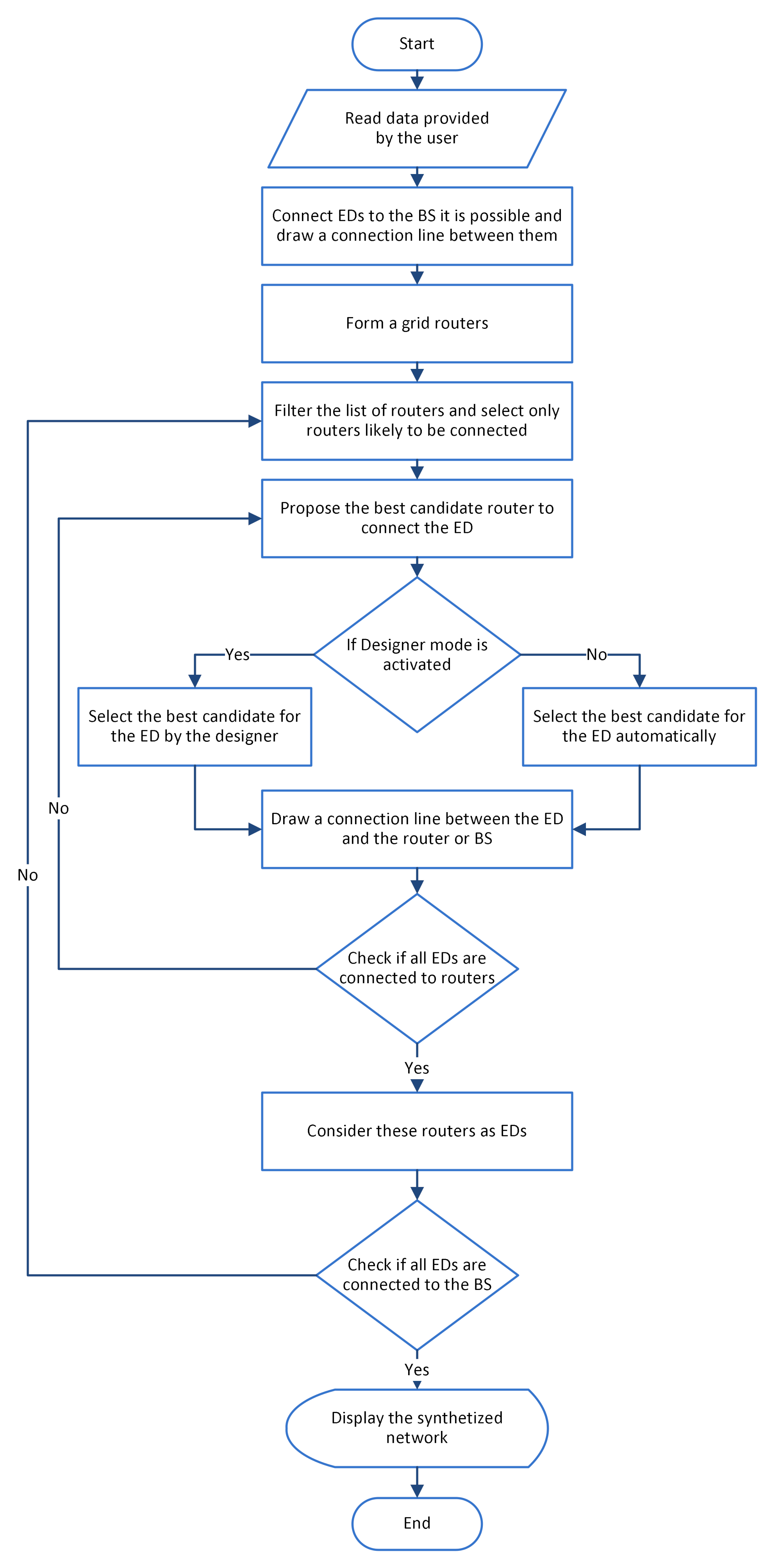
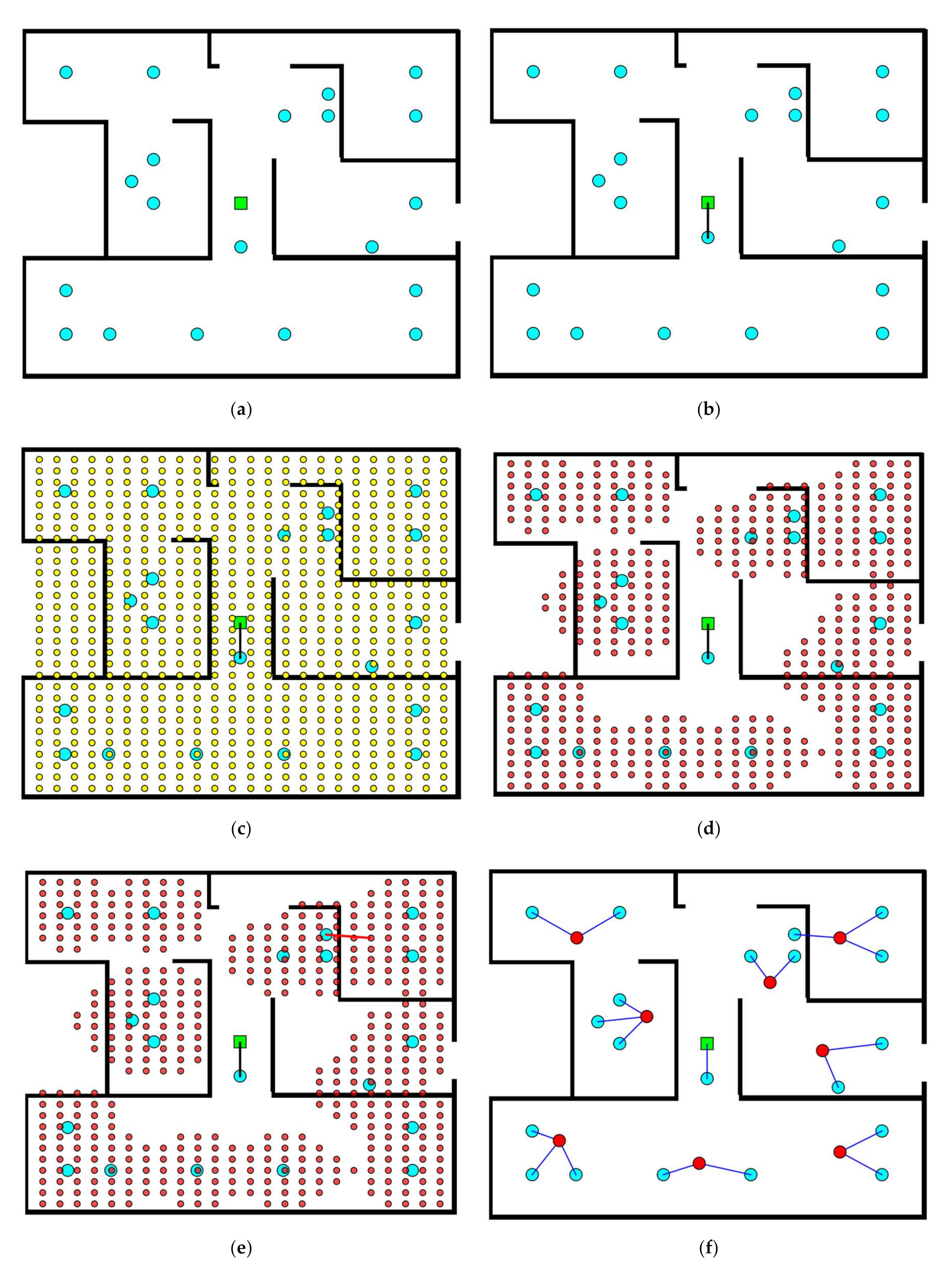
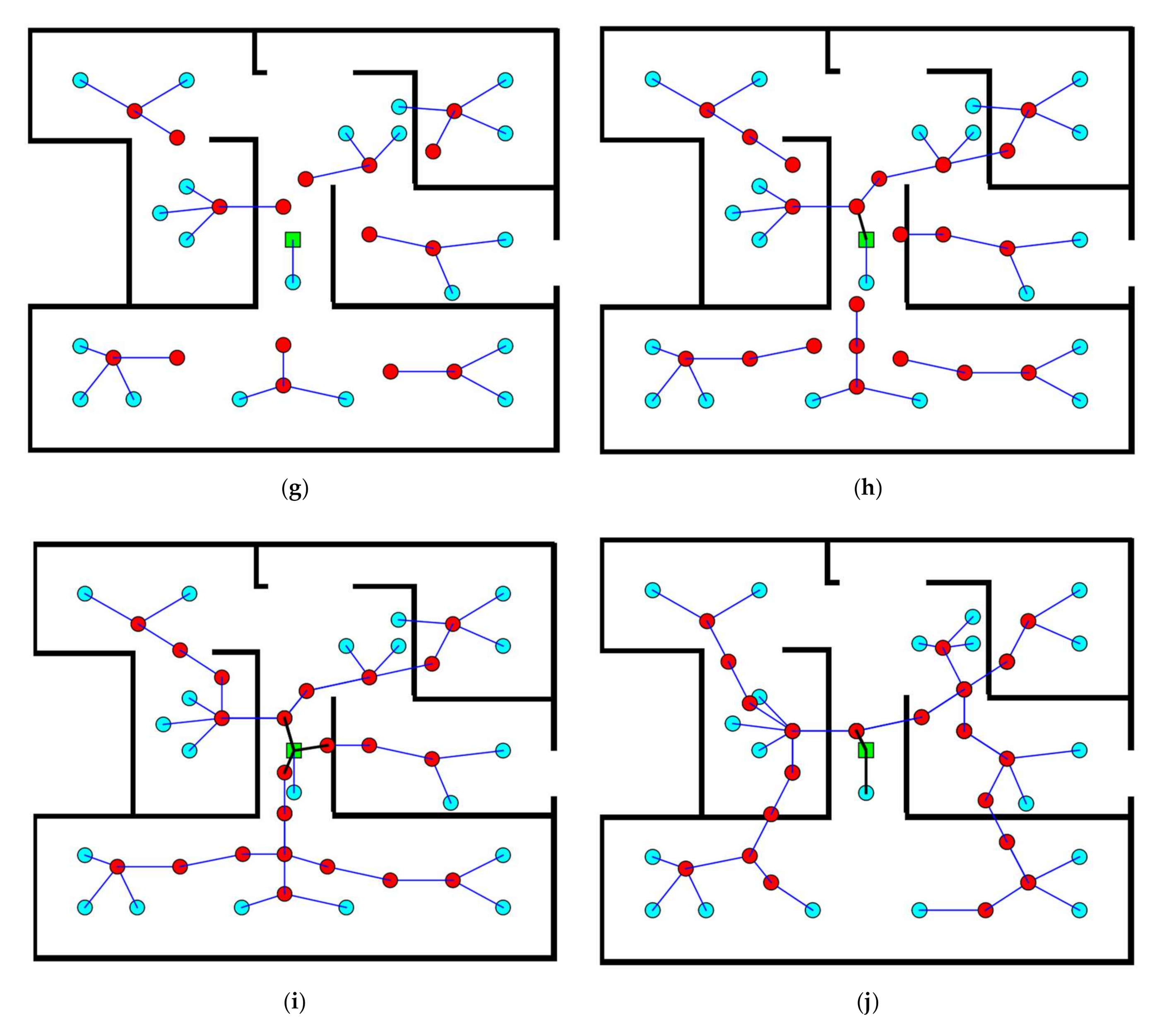
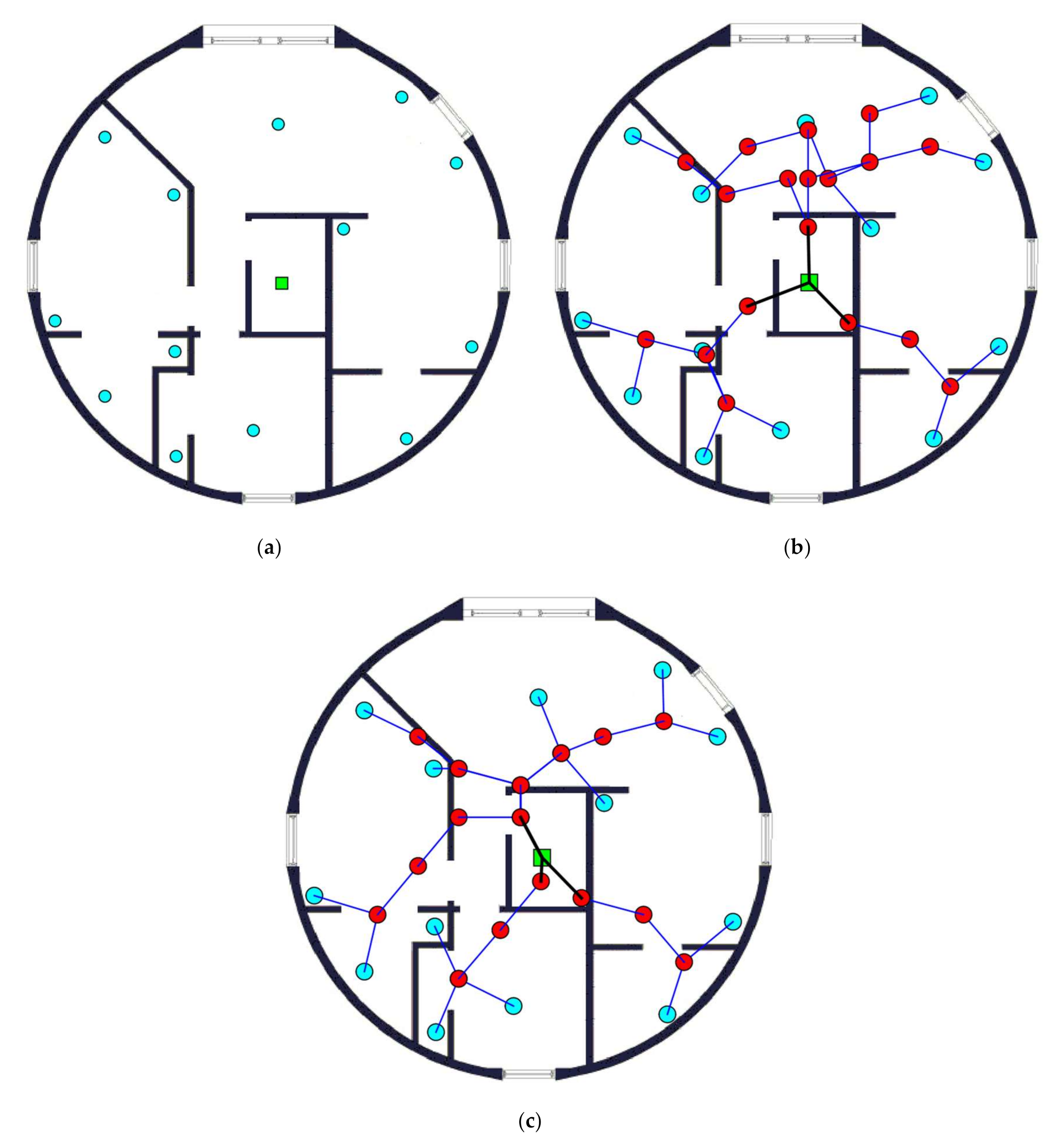
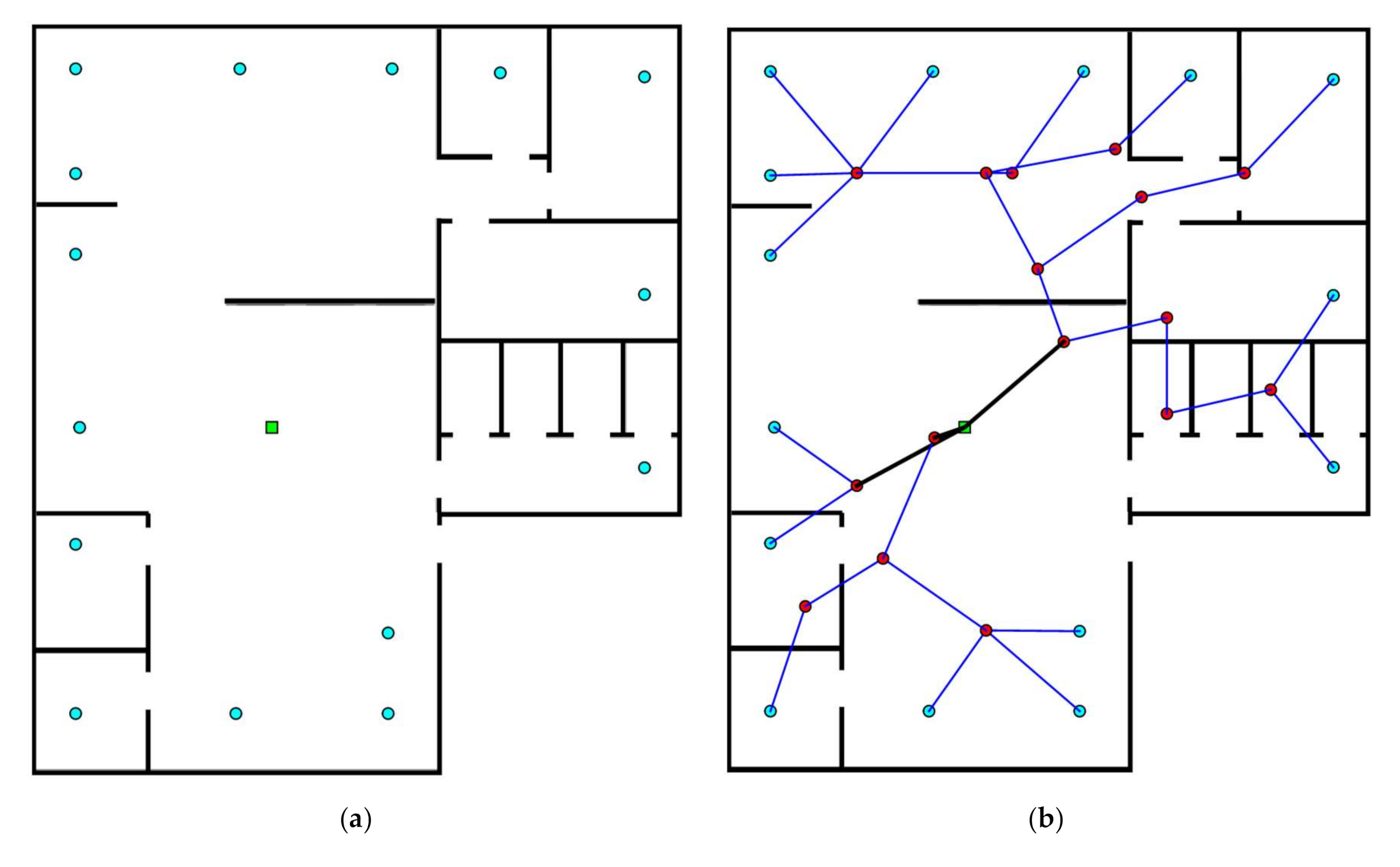
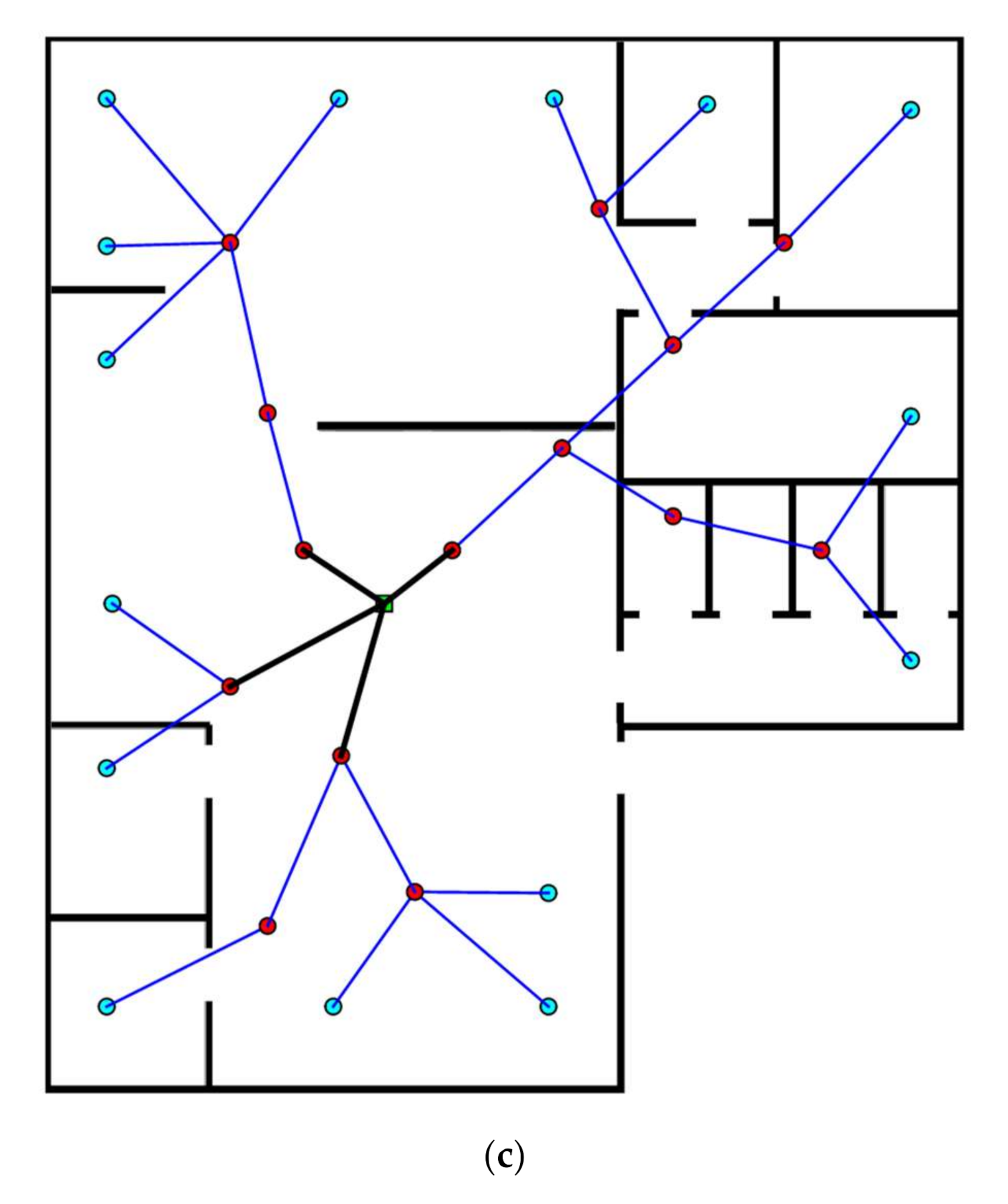
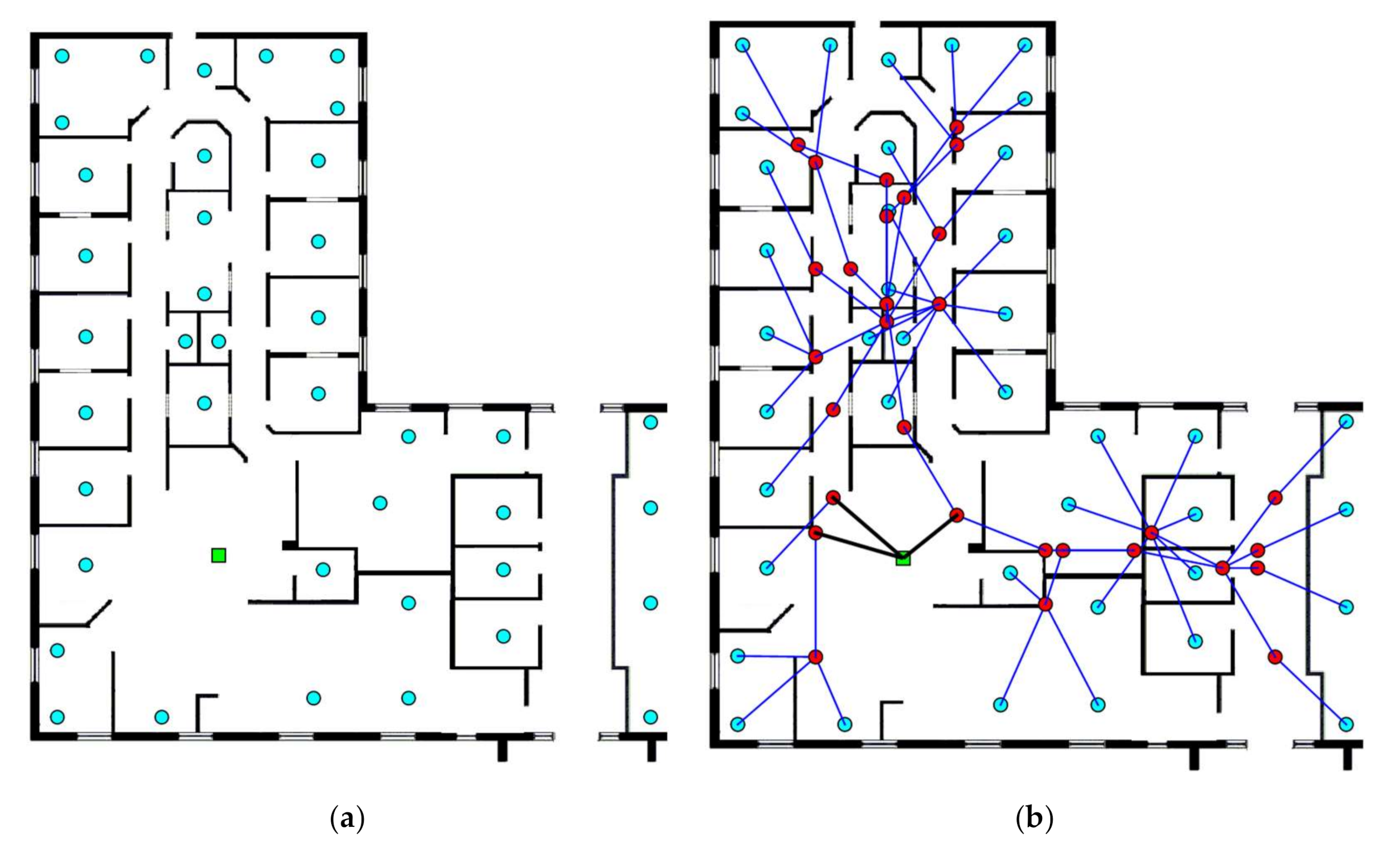
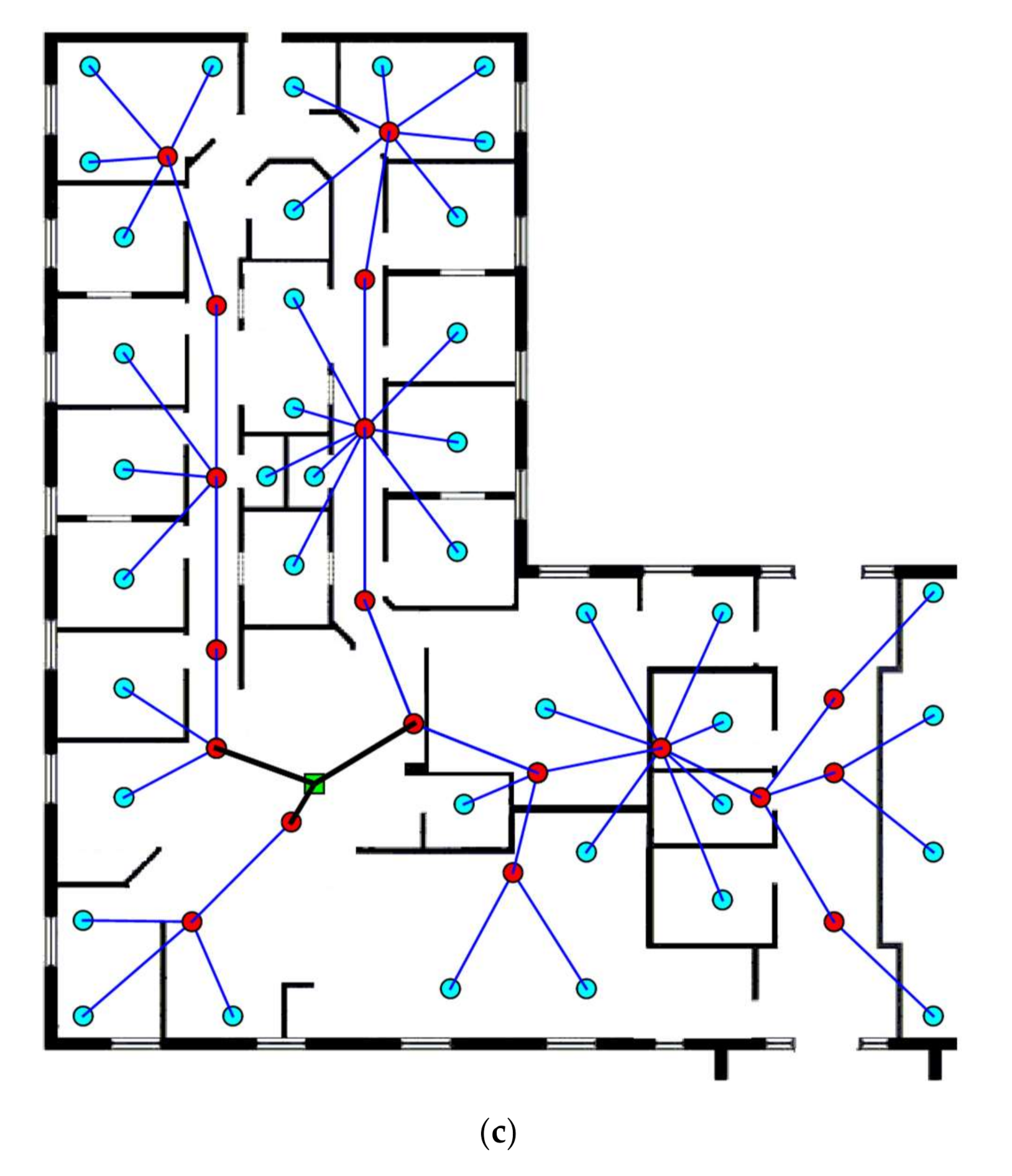
| Node # | Node Type | x | y |
|---|---|---|---|
| 1 | 1 | 225 | 225 |
| 2 | 2 | 76 | 101 |
| 3 | 2 | 34 | 257 |
| 4 | 2 | 134 | 150 |
| 5 | 2 | 135 | 283 |
| 6 | 2 | 76 | 321 |
| 7 | 2 | 136 | 372 |
| 8 | 2 | 201 | 350 |
| 9 | 2 | 330 | 357 |
| 10 | 2 | 385 | 279 |
| 11 | 2 | 277 | 179 |
| 12 | 2 | 326 | 67 |
| 13 | 2 | 222 | 90 |
| 14 | 2 | 372 | 123 |
| 15 | 3 | 87 | 273 |
| 16 | 3 | 121 | 123 |
| 17 | 3 | 121 | 232 |
| 18 | 3 | 155 | 150 |
| 19 | 3 | 155 | 191 |
| 20 | 3 | 155 | 327 |
| 21 | 3 | 190 | 286 |
| 22 | 3 | 207 | 164 |
| 23 | 3 | 207 | 191 |
| 24 | 3 | 224 | 245 |
| 25 | 3 | 241 | 137 |
| 26 | 3 | 258 | 259 |
| 27 | 3 | 276 | 123 |
| 28 | 3 | 310 | 273 |
| 29 | 3 | 327 | 110 |
| 30 | 3 | 344 | 313 |
| Node # | Node Type | x | y |
|---|---|---|---|
| 1 | 1 | 75 | 75 |
| 2 | 2 | 18 | 215 |
| 3 | 2 | 18 | 285 |
| 4 | 2 | 85 | 285 |
| 5 | 2 | 148 | 285 |
| 6 | 2 | 148 | 252 |
| 7 | 2 | 255 | 183 |
| 8 | 2 | 255 | 112 |
| 9 | 2 | 255 | 22 |
| 10 | 2 | 195 | 20 |
| 11 | 2 | 150 | 18 |
| 12 | 2 | 87 | 18 |
| 13 | 2 | 18 | 18 |
| 14 | 2 | 18 | 62 |
| 15 | 2 | 18 | 95 |
| 16 | 2 | 20 | 167 |
| 17 | 3 | 55 | 61 |
| 18 | 3 | 55 | 191 |
| 19 | 3 | 66 | 111 |
| 20 | 3 | 66 | 261 |
| 21 | 3 | 76 | 151 |
| 22 | 3 | 87 | 211 |
| 23 | 3 | 109 | 251 |
| 24 | 3 | 120 | 151 |
| 25 | 3 | 152 | 121 |
| 26 | 3 | 163 | 51 |
| 27 | 3 | 185 | 91 |
| 28 | 3 | 185 | 141 |
| 29 | 3 | 218 | 61 |
| 30 | 3 | 229 | 151 |
| Node # | Node Type | x | y |
|---|---|---|---|
| 1 | 1 | 100 | 275 |
| 2 | 2 | 18 | 13 |
| 3 | 2 | 63 | 13 |
| 4 | 2 | 18 | 48 |
| 5 | 2 | 30 | 75 |
| 6 | 2 | 30 | 118 |
| 7 | 2 | 30 | 160 |
| 8 | 2 | 30 | 200 |
| 9 | 2 | 30 | 240 |
| 10 | 2 | 30 | 280 |
| 11 | 2 | 15 | 325 |
| 12 | 2 | 15 | 360 |
| 13 | 2 | 70 | 360 |
| 14 | 2 | 328 | 360 |
| 15 | 2 | 328 | 300 |
| 16 | 2 | 328 | 250 |
| 17 | 2 | 328 | 205 |
| 18 | 2 | 250 | 318 |
| 19 | 2 | 250 | 283 |
| 20 | 2 | 250 | 253 |
| 21 | 2 | 155 | 283 |
| 22 | 2 | 125 | 13 |
| 23 | 2 | 163 | 13 |
| 24 | 2 | 163 | 40 |
| 25 | 2 | 153 | 68 |
| 26 | 2 | 153 | 110 |
| 27 | 2 | 153 | 150 |
| 28 | 2 | 153 | 190 |
| 29 | 2 | 93 | 20 |
| 30 | 2 | 93 | 65 |
| 31 | 2 | 93 | 98 |
| 32 | 2 | 93 | 138 |
| 33 | 2 | 83 | 163 |
| 34 | 2 | 100 | 163 |
| 35 | 2 | 93 | 195 |
| 36 | 2 | 185 | 248 |
| 37 | 2 | 200 | 300 |
| 38 | 2 | 200 | 350 |
| 39 | 2 | 150 | 350 |
| 40 | 2 | 250 | 213 |
| 41 | 2 | 200 | 213 |
| 42 | 3 | 46 | 46 |
| 43 | 3 | 55 | 326 |
| 44 | 3 | 64 | 100 |
| 45 | 3 | 64 | 163 |
| 46 | 3 | 64 | 226 |
| 47 | 3 | 64 | 262 |
| 48 | 3 | 92 | 289 |
| 49 | 3 | 119 | 91 |
| 50 | 3 | 119 | 145 |
| 51 | 3 | 119 | 208 |
| 52 | 3 | 128 | 37 |
| 53 | 3 | 137 | 253 |
| 54 | 3 | 173 | 308 |
| 55 | 3 | 182 | 271 |
| 56 | 3 | 228 | 262 |
| 57 | 3 | 264 | 280 |
| 58 | 3 | 291 | 244 |
| 59 | 3 | 291 | 271 |
| 60 | 3 | 291 | 326 |
Publisher’s Note: MDPI stays neutral with regard to jurisdictional claims in published maps and institutional affiliations. |
© 2020 by the authors. Licensee MDPI, Basel, Switzerland. This article is an open access article distributed under the terms and conditions of the Creative Commons Attribution (CC BY) license (http://creativecommons.org/licenses/by/4.0/).
Share and Cite
Alanezi, M.A.; Bouchekara, H.R.E.H.; Javaid, M.S. Optimizing Router Placement of Indoor Wireless Sensor Networks in Smart Buildings for IoT Applications. Sensors 2020, 20, 6212. https://doi.org/10.3390/s20216212
Alanezi MA, Bouchekara HREH, Javaid MS. Optimizing Router Placement of Indoor Wireless Sensor Networks in Smart Buildings for IoT Applications. Sensors. 2020; 20(21):6212. https://doi.org/10.3390/s20216212
Chicago/Turabian StyleAlanezi, Mohammed A., Houssem R. E. H. Bouchekara, and Muhammad S. Javaid. 2020. "Optimizing Router Placement of Indoor Wireless Sensor Networks in Smart Buildings for IoT Applications" Sensors 20, no. 21: 6212. https://doi.org/10.3390/s20216212
APA StyleAlanezi, M. A., Bouchekara, H. R. E. H., & Javaid, M. S. (2020). Optimizing Router Placement of Indoor Wireless Sensor Networks in Smart Buildings for IoT Applications. Sensors, 20(21), 6212. https://doi.org/10.3390/s20216212






